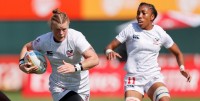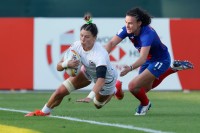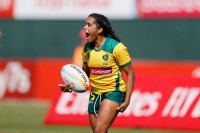Why the USA Women 7s Are Better than 7th Place
Why the USA Women 7s Are Better than 7th Place
Seventh place isn’t so great for the USA Women’s 7s team, but it may not be an accurate reflection of the quality of the Eagle team.
First off, let’s leave aside the rather distressing 45-5 loss to Australia in the opening game of the first tournament in Dubai. The USA team wasn’t ready for an Australian team that was, clearly, the best team there. The Aussies had only one close game (more on that later) in cruising to the Cup. We’ll, for now, consider a do-over regarding that game.
Two Wins and We Forget Australia
And the rest? Well the Eagles ended up playing a pretty snappy little game against France, using their aggression to create scoring opportunities.
Their first try was from a classic sidestep and break from Alev Kelter. Her offload bounced off Ilona Maher’s face, which is not a knock-on, and the referee was attentive enough to see that. Maher gathered and was over. The second was thanks to pressure from Maher, which forced a drop and she picked up, connected with Sia A’au and she passed to Kris Thomas who beat two on her way to the try.
The Eagles made it a commanding 19-7 lead at halftime when Kelter forced a penalty in the ruck and then put in a perfect-catch-and-pass to get the ball wide and Naya Tapper set up Abby Gustaitis.
Kelter’s aggressiveness in the breakdown is a good thing because it creates turnovers and forces penalties, but it can also backfire when she pushes the limits too much. In addition to that, the USA team just wasn’t playing as if they were concerned with France’s physicality.
They almost put the game away early in the second half when Jaz Gray seemed off to the corner. She was just ankle-tapped down, which points to her inexperience; a finisher like her has to be conscious of changing her vector and running in a balanced way so she can’t be taken down easily—Carlin Isles is superb at this.
The result was no try and France came back to score thanks to a penalty and some flat play from the USA. But the Eagle did put it away when Maher galloped 90 meters to score, showing a ton of desire in doing so.
So going into the next two pool games the Eagles were in OK shape at 1-1. They held off a speedy and difficult Spain team in which they won on pace—Gray scored two excellent tries and Tapper’s try turned a 12-10 deficit into a win on a run that showed she still has a turn of pace.
Then What?
Then what? They lost to Brazil is what. They lock to Brazil on a mistake—three players worrying about a ruck they were losing and not covering the weak side—and they lost to a fluke.
Yes it wasn’t a great game for the USA team, but they were still leading 10-7 with basically no time left and were chasing their own restart. Gustaitis came in to make a tackle and also knocked the ball back to her side. But the rugby ball is a funny shape and it ended up in the hands of Thaila Costa, who took off to score the winner for Brazil.
Nine times out of 10 that loose ball ends up in USA hands.
Had they won that game against Brazil the USA team would have played Russia for the Bronze Medal, a game they probably would have won (France beat the Russians 40-0). But because they didn’t they ended up plying Canada for 7th, a game the Eagles won 17-7.
(Canada’s rugby programs are struggling.)
In that 7th-8th game Spiff Sedrick, who, along with Maher is a former MA Sorensen Award-winner as the top collegiate player in the country, scored a nice heads-up try and Tapper added two.
So all of this is to outline that the USA is not that bad. They can score with speed; they can score with power; they can defend (at least after the Australia game); they can work together.
How to make an entrance, by @USARugby's @AbbyGustaitis #HSBC7s pic.twitter.com/fGeHyF3q6e
— World Rugby (@WorldRugby) November 27, 2021
But there are things that need fixing:
Goalkicking
Kelter is the USA’s all-time-leading scorer, and she and Alena Olsen were a combined 4-for-13. Several of these misses were kicks that really need to be made, and we spotted Kelter pulling her head up on a few kicks, which is a big no-no if you want to be accurate. Lack of conversions were the difference against Brazil.
Passing
The slow passing directly to players standing still has to stop. The Eagles at times gave up massive amounts of territory with that. You can give up territory in 7s but only if you’re moving and getting support behind you.
Holding-on Penalties
(This is also a problem for the USA 15s team.) If you’re making a half-break, getting tackled is a problem if you’ve left your support behind you have to adjust; you can’t just go down to the ground and hold the ball there; you’ve got to get the ball out of reach of the next defender coming into the breakdown.
Tackling
The USA does well when they drive a shoulder into a ballcarrier’s ribs, keep their feet on the floor, and use those cleats to drive the ballcarrier back and down. Ouch. Opposition goes backward, and ball can be dropped.
The arm tackles, especially the weak, imploring arm tackles around another player’s arms are fairly useless. It’s one of those moves that works maybe 20% of the time and all anyone remembers is that 20%. You can’t win World Series tournaments tackling like that.
(OK, so we promised something about France. The French, after losing to the USA, ended up losing to Australia 24-22. They were they only team to come even remotely close to the Aussies. So the USA can beat France but lose to Australia by 40? It’s a puzzler.)
















